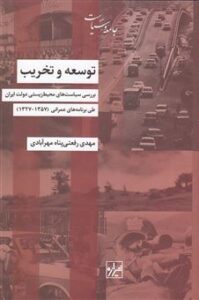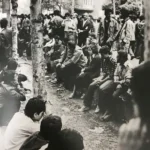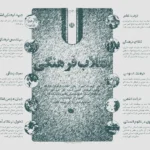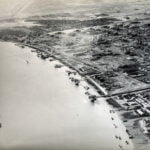/Book Review | Reading Time: 11 minutes
Development and Destruction
An Analysis of Iranian State’s Environmental Policies under Development Planning (1948-1979)
Vahid Dehghani
November 18, 2024
 Capitalist development, or economic development for that matter, has been characterized as a process of creative destruction. This powerful process of transformation destroys existing social relations as well as landscapes, ecosystems, and natural environments to create an environment more conducive to economic growth. It was a widely held assumption among development practitioners that economic theory was to facilitate this process. It was further assumed that what was being born was worth the social and environmental costs. These implicit assumptions were only seriously challenged in the mid-1980s when it was becoming clearer by the day that the social and environmental destruction was irreversible, but the expected development and its benefits were nowhere in sight. Inspired by French philosopher Michele Foucault, many scholars embarked on a critical reassessment of the experience of development and modernization in many parts of the world. This intellectual turn was later known as post-development theory. This new wave has been slow to reach Iran and the number of books that are informed by a critical gaze at the Iranian experience of top-down development practices are few and far between. Mehdi Rafatipanah Mehrabadi’s Development and Destruction tries to fill this gap.
Capitalist development, or economic development for that matter, has been characterized as a process of creative destruction. This powerful process of transformation destroys existing social relations as well as landscapes, ecosystems, and natural environments to create an environment more conducive to economic growth. It was a widely held assumption among development practitioners that economic theory was to facilitate this process. It was further assumed that what was being born was worth the social and environmental costs. These implicit assumptions were only seriously challenged in the mid-1980s when it was becoming clearer by the day that the social and environmental destruction was irreversible, but the expected development and its benefits were nowhere in sight. Inspired by French philosopher Michele Foucault, many scholars embarked on a critical reassessment of the experience of development and modernization in many parts of the world. This intellectual turn was later known as post-development theory. This new wave has been slow to reach Iran and the number of books that are informed by a critical gaze at the Iranian experience of top-down development practices are few and far between. Mehdi Rafatipanah Mehrabadi’s Development and Destruction tries to fill this gap.
“Policy-making in Iran is useless since most policies have resulted in nothing but failure.” This is a belief shared by many Iranians when one asks their opinion about policy-making in their country. In fact, many Iranians blame the sad condition of the country on ‘wrong policies’ that have been taken and implemented over decades. Environmental issues are no exception. The root cause of drying wetlands, dust bowls, deforestation, loss of biodiversity, and many other problems are to be sought in policy circles and bad policies. Development and Destruction is a history of environmental regulations in Iran with a focus on five development plans that were implemented between 1948 and 1978. A historian by training, Dr Mehrabadi’s book is a thorough examination of all types of rules and regulations related to environmental issues before Iran’s 1979 Revolution. Offering a detailed description of environmental rules and policies, and a critical evaluation of how environmental discourse around development politics was shaped, Development and destruction is an important contribution to the history of environmental policies in Iran. At the same time, it provides insights into the dominant policy-making paradigm in Iran and tries to analyze why so many plans for improvement ended in failure. The central question of this study is why there was no powerful environmental social movement in the Pahlavi Era (p 23). It also tries to show that the existing models of modernization were unsustainable (ibid). It characterizes Pahlavi era development practices as absolutist and pseudo-modernist.
The book is divided in three long chapters. The first chapter is devoted to environmental policies in the period of the Constitutional Revolution (1905-1911) to the end of the second development plan (1962). Before explaining policies, the author provides information about policy-making models and environmental policy-making approaches. According to the author, the dominant model of policy-making in Iran was a top-down institutional model in which most of the policies were taken and implemented by the government and the level of peoples’ participation in the policy-making processes was negligible. This is taken to be one of the main flaws in development politics of the time. Under an ‘absolutist state’ in pursuit of ‘pseudo-modernization’ (p 544), even the best policies will prove counter-productive.
The first law with environmental relevance in Iran was “Law of the Formation of States and Provinces and Instructions to the Governors”[1] in which one of the duties of local governors was to protect jungles and the first organizations in charge of forestry were the Ministry of Agriculture and the Forestry Organization, both established in 1940. The first independent law about the jungles in Iran was enacted in 1942, in which, the Ministry of Agriculture was put in charge of the conservation and protection of jungles. In the field of water resources, several rules were ratified before the first development plan. They were mainly related to the ownership of water resources, drilling licenses, and water quality. In fact, the most important rule about water resources was the civil law in which public water resources were put outside private control and nobody was allowed to gain control of these resources. The establishment of an independent Irrigation Company(Sazeman-e Ab) was another important activity of the government before the first development plan.
Like many other countries in search of development, comprehensive plans were the main vehicle for devising and implementing economic policies in Iran. Each plan contained many policies and specific projects. Because of the political and economic chaos during the Nationalization of the Iranian Oil Industry (1951-1953) and the ensuing imposed international sanctions, only a third of the planned financial resources were provided for the first development plan (1948-1955). However, some helpful actions were undertaken during the first development plan including programs to identify aquifers and properties of each aquifer, formation of Jungle Company[2] for protection of jungles, and some other programs which were done in cooperation with Point Four Program. An important point about the first development program is that different studies were conducted on the common methods of forest exploitation, all of which indicated that production of charcoal had the most destructive effect on jungles. Therefore, the Jungle Company was established to manage forestry affairs by issuing logging licenses, formation of Jungle Guard[3], and other regulations. Nevertheless, there was no considerable reduction in the production of charcoal after creation of the Jungle Company.
During the second development plan (1955-1962), new organizations were established to administer different environmental issues. Forestry Organization[4] took the place of the Jungle Company. It was decided that a forestry plan should be devised for each forest to identify available resources and outline the corrective actions that should be taken to protect the resource. About hunting, the first hunting rule was ratified in 1956 and a Hunting Center[5] was created to protect endangered species and to issue hunting licenses. Overall, the formal policy of hunting in this period was to create protected areas and prohibit hunting of endangered species. One of the most critical policies of Iranian government in all development plans was to increase areas under cultivation of agricultural products. According to this policy, different studies were conducted during the second development plan to find the best way to increase water supply for agriculture. The solution, unfortunately, was drilling deep and semi-deep wells which ushered in later catastrophic problems of ground water resources.
The second chapter of the book is about the third and fourth development plans. The third development plan (1962-1967) began with very important rule about forests, i.e. Law of Nationalization of Forests. By nationalizing the forests, the road was paved for the government to enhance its control on all the forests and to forbid almost any kind of private use. While such a development could have been a milestone in the protection of forests, it in fact turned forests into a tool in the hands of government for reaching its political and economic goals. Pastures were also nationalized by the Law of Nationalization of Forests and shepherds needed to take a license for pasturing their livestock in national pastures. In 1967, “Law of Protection and Exploitation of Forests and Pastures”[6] was authorized, as a result of which the scale and scope of forests and pastures under protection were increased dramatically. At the same year, the second law of hunting was passed and new concepts like protected animals were introduced into the environmental rules. Besides, Hunting Organization[7] was established and the responsibility of protection of animals and monitoring of fishing was given to this organization. In 1966, parliament passed the first law about groundwater protection to restrict overuse especially by imposing restrictions on drilling deep and semi-deep wells in areas that the level of groundwater had fallen considerably. The last point in regard to the third development plan is that government was successful in reducing charcoal production. The main reason for this success was a shift in people’s lifestyle, namely, the replacement of charcoal with oil for household consumption.
During the fourth development plan (1967-1972) previous laws about jungles and pasture were revised. As a result, the Ministry of Natural Resources was formed and overtook the responsibilities of the previous Forestry Organization. Through this period, different programs, with cooperation from a few international organizations, were planned for forest restoration. The new ministry was also responsible to create similar plans for pastures restoration. Besides, a Pastures’ Development Fund[8] was created to help to restore pastures. However, not only did the area of land under grazing not decline during this period, but also the number of livestock kept growing. It should be mentioned that four years after the creation of the Ministry of Natural Resources this ministry was dissolved and a new organization was developed to address environmental issues. This cycle of establishing and abolishing organizations was not problem free and was a sign that no real clear plan to address pressing environmental issues existed at the time. In 1968, a law was ratified for restricting fishing in the Caspian Sea which mandated owning a license for fishing. In the same year, water resources were also nationalized. It is important to consider the goal of expansion of agriculture in the nationalization of water since nationalization would enable the government to easily allocate water to agricultural purposes. Concerning wastewater, the government regulated how industrial wastewaters should be treated based on their temperature and ingredients. According to the fourth development plan, all actions related to soil erosion should have been concentrated in a few specialized organizations; hence, the Soil Organization[9] and Soil Institute[10] were formed to study all issues related to soil. Besides, the government started to mulch a great part of Iran’s deserts, more than 2000 hectares per year, to stabilize the dust. At the end of the fourth plan, the Ramsar Convention (1971), named after a city in the northern Iran, was passed to protect wetlands as habitats of waterfowls. It is considered as one of the most important environmental agreements in the world.
The last chapter of the book is devoted to the fifth development plan. The fifth development plan (1973-1977) coincided with the Arab-Israeli war (1973) which caused a great hike in oil prices. As a result, just after a few months the plan was revised, and the financial resources of the plan grew by 68%. This huge increase is considered to be the main cause behind many failures of the fifth plan since the country lacked sufficient infrastructure to provide for all the provisions of the new enlarged plan. For the first time, the fifth plan contained a separate chapter for the environment. The planners also paid attention to the precautionary principle. For solving the problem of lack of cooperation between organizations in the fifth plan, the National Association for the Protection of Natural Resources and Human Environment[11] was formed with a membership of all responsible officials. During the fifth development plan, numerous projects were carried out to improve the old forests. One of the famous and harmful projects was the project of cultivating needleleaf trees to provide resources for the paper industry. Introducing new species into any ecosystem could cause problems. The problem with this project was that most needleleaf trees were not compatible with Iran’s environment so they caused many unforeseen troubles including an increase in the number of fungi and harmful insects. In 1975, nearly a million fish were dead in the Zarjub River and a year after that, the same thing happened again. These catastrophic events forced the government to set regulations for industrial wastewater treatment. Yet, the regulations were not taken seriously as much as expected. Another source of river pollution was the overuse of chemical fertilizers which happened by the encouragement of the government to increase agricultural output. As oil production has been growing up, the government passed a law in 1975 to protect seas and border rivers from oil pollution. Therefore, the Iranian government reached a number of agreements with neighboring countries, including Iraq, to protect riparian rivers and water bodies. During the fifth development plan, dust bowls remained one of the country’s main environmental problems. The government expanded the watershed projects and invested in the creation of green belts in some desert areas. These projects were among the noticeable success stories of the government. In 1970s air pollution was emerging as a major problem in Iranian cities. After a five-year debate, air pollution prevention regulations were passed in 1975 to curb air pollution. The Department of Environment was commissioned to identify all sources of air pollution and take proper actions to control them.
As we have seen, tremendous amount of effort was undertaken to protect the environment before the 1979 Islamic Revolution in Iran. These efforts included ratifying new rules and regulations and establishing different organizations for environmental protection. Nonetheless, according to the data provided in this study, the gap between the ideal and reality of Iran’s environmental performance at that time was huge. The author identifies two main reasons for this chasm: Firstly, Iranian politicians had other priorities like increasing agricultural production over protecting the environment. Further compounding this, Iranian policymakers did not have a proper understanding of environmental policies and how they interacted with other policies. Secondly, the general attitude and tenor of Iranian government was that of an absolutist state. As a result, the government viewed economic development as a process that was carried out by command. The government did not consider the social and political prerequisites of development plans. In other words, the development policies in Iran were based on the institutional model of policy-making, with all its usual symptoms. Furthermore, the great jump in the oil revenue of the Iranian government increased the distance between the people and the government because the government was even less inclined to seek people’s participation in the development process. Though the Iranian government tried to close the gap with the people by actions such as creating the Health Corps, but even these actions were done on the wrong idea of development based on command.
The main question raised at the begging of the book, i.e., lack of a vigorous environmental social movement that would force the state towards a more responsible stewardship of the nature, is answered by reference to the repressive presence of an all-powerful state (p 457-8). It is also argued that the state failed to educate the public about the significance of environmental protection and thus further alienated the general population from itself. Segments of the population whose livelihoods were directly linked to an exploitation of natural resources found no way but to resist state policies. To counter their resistance, the state relied more heavily on its coercive power (p 549). The end result was predictable: while the state did take measures to mitigate the destructive impact of its development plans, it failed to produce any appreciable outcome. Deforestation, air pollution, desertification, land salination, loss of biodiversity, and all the other ills associated with rapid economic transformation were on the rise.
While the author offers a detailed account of institutional and legal aspect of policy-making, the analysis provided in the book leaves much to be desired. The author criticizes destructive edge of development practice mainly as “conceptual turn” (p 19) that in turn translated into a “behavioral turn” that shaped the way humans interacted with nature (ibid). He idealizes a lost harmonious past in which “humans, God, and nature, formed an intertwined unified whole that aimed at human spiritual elevation” (ibid). When reading the book, it is hard to avoid remembering E. P. Thompson’s warning against “the enormous condescension of posterity”. No effort has been made to situate development practices in Iran within a wider historical and geographical context. Why were so many countries with different histories, cultures, and political structures during the same period so obsessed with economic development, followed the same models that produced similar results? Top-down, non-participatory development practices were hardly limited to Iran. Nor was there a vigorous environmental movement present in any other nation in pursuit of development. And the question remains, how can we blame the state for the lack of a movement that was supposed to make the very same state more accountable?
Parts of the book are repetitive. There are no clear connections between events. In some chapters, there are contents that seem irrelevant to the subject at hand. A summary, a table, or diagram at the beginning of each chapter would have clarified the relation between rules and programs and the chronology of the different actions. These shortcomings notwithstanding, Development and Destruction is a uniquely valuable book for understanding the history of environmental policy-making in Iran. It not only provides a detailed history of all environmental rules and regulations, but it also explains the overall atmosphere of policymaking in Iran before the 1979 Revolution. The author’s effort to critically engage with developmental practices and their impacts is worthwhile. All in all, Development and destruction is a great source for all scholars who want to become familiar and do research about environmental policy-making in Iran. Its detailed account of how laws, regulations, policies, and institutions were formed during this crucial historical period and its extensive bibliography are indispensable to researchers interesting in Iran’s environmental policies, development, or the Pahlavi era in general.
Endnotes
- Qhanoon-e Tashkil-e Eyalat va Velayat va Dastoorlolamal Hokam ↑
- Bongah-e Jangqal ↑
- Gard-e Jangal ↑
- Sazman-e Jangalbani ↑
- Kanoon-e Shekar ↑
- Qhanoon-e Hefazat va Bahrebardari az Jangalha va Marate ↑
- Sazman-e Shekarbani ↑
- Sandoghe Omran-e Marate ↑
- Moasese Khak Shenasi ↑
- Anistitu Khak ↑
- Anjoman-e Meli Hefazat az Manabe Tabiyie va Mohit-e Ensani ↑









Comments are closed.